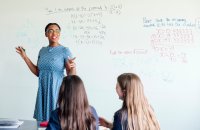Teaming Up With Researchers To Improve Classroom Practice
A researcher helps a math teacher devise new ways to increase retention—and student engagement.
Your content has been saved!
Go to My Saved Content.In this first person narrative from EdSurge, high school math teacher Bill Hinkley writes about the power of coupling research experts with teachers in the classroom. As part of a program by The Learning Agency, teachers and researcher are paired together and “each duo identifies a practice to experiment with and shares out about implementation.”
Hinkley worked with Dr. Yana Weinstein-Jones on spaced practice, an evidence-backed strategy for improving knowledge retention. The concept is simple and the research compelling: Spreading instruction out over multiple shorter sessions is more effective than a single, longer session.
But how do you implement spaced practice when high school math is “bullet-pointed into units, chapters, subheadings and indicators”—and with the looming pressure of Maine’s state assessments hanging over the whole undertaking? The pressure to tick off all of the content areas fights with the need to return to it, engage with it again, and help the students learn it more deeply.
Hinkley started by using informal data collection from students to track whether his current implementation of spaced practice was working. Several hand-picked students kept records, over several months, of when they focused on a particular math skill—both inside and outside of class time. That window into the repeated exposure to a math concept proved invaluable, as both students and teacher could chart progress and make adjustments to their approach.
“Dr. Weinstein-Jones hypothesizes that a significant aspect of spaced practice is providing learners with opportunities to consider an idea informally,” Hinkley writes, “and that when teachers carve out structured times for learners to think about a new idea in class and encourage them to think about it on their own, the understanding is notably strengthened.”
Allowing time and space for independent exploration may seem counterintuitive in an assessment-driven environment, but the exercise solidified a few key takeaways for Hinkley. Thinking ahead about ways to space out the learning—and keeping track of it as you go—helps avoid “the compartmentalization inherently promoted by curriculum designers.” Spacing also showed Hinkley the value of regularly and intentionally integrating skills from prior lessons into the next unit, and into activities like homework and group work. By avoiding a “one-and-done” mentality, he increased engagement and learning.
Increasingly, Hinkley is asking himself, “How can I enrich the learning experience so that students are naturally thinking about the topic outside of classroom and during homework time?” The lesson about spacing extends to a greater lesson: some of the best teaching sparks a curiosity in students that reaches beyond the designated class time.
The graph inset above is an excerpt from a longer timeline. You can see the whole graph as an inset on EdSurge.
